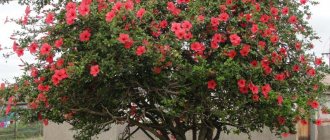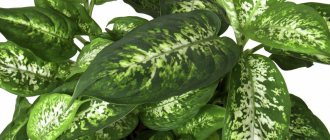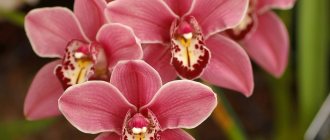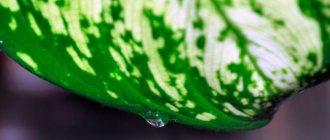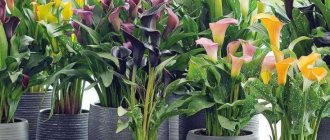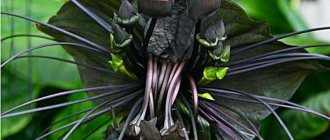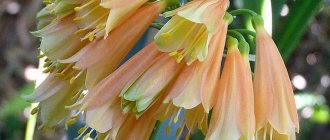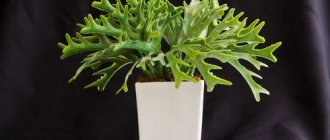Ivy evergreen
This plant is a climbing vine with sinewy leaves of a deep green color. Ivy is easy to care for and grows quite quickly. The stem has thin shoots with which the plant can grow vertically.
There is a folk superstition associated with evergreen ivy - the more luxuriant it grows, the faster the marriage breaks up. In addition, foliage that is too dark poses a danger to love, romantic and family relationships.
Dieffenbachia
An evergreen plant with beautiful, voluminous, ovate green leaves with an unusual yellowish pattern. An adult Dieffenbachia can reach 2 meters in height. This is a rather capricious flower: without increased care, the foliage begins to dry out and then falls off.
Popular belief says that growing Dieffenbachia in the house causes problems with potency in men. In addition, the sap of the plant is poisonous; when evaporated, it causes migraines, and when it comes into contact with the skin, it causes burns. Despite such fame, people like to decorate balcony interiors with Dieffenbachia.
Ficus
Ficus is one of the most controversial plants regarding superstitions. Thus, some classify him as a “husband buster,” capable of driving suitors away from a girl or severely ruining the character of a spouse. According to other beliefs, the flower increases the chances of conception, and it is recommended to grow it for childless couples dreaming of children. It also attracts happiness and wealth to the home.
Characteristic
Muzhegon flowers (photos and names are given in the material) - ficuses belong to the Mulberry family and in their natural environment they grow in tropical and subtropical regions of Africa, Asia, the Mediterranean and Australia. More than 2,000 species of these evergreen subshrubs are known.
But at home, the following varieties are most often cultivated:
| Description | Peculiarities | |
| Ficus rubbery | The plant reaches up to 2 m in height. Its glossy oval leaves, colored green, may have yellow or white spots and streaks. | The variety has an unpretentious character and easily takes root in shaded areas. |
| Ficus benjamina | Compact species, the height of which does not exceed 1.5 m. The leaves are small, oval, pointed at the tips. May have white or yellow edging, stripes and heel. | It tolerates pruning easily and can be easily shaped into a standard tree or bonsai. |
| Ficus lyreformes | A tree-like variety, the height of which reaches up to 2.5 m. It is distinguished by larger leaves with a “grooved” glossy surface. | The annual growth of the plant is about 25 cm. And it is worth growing it in spacious rooms. The Bambino variety is suitable for small apartments. |
| Ficus dwarf | It differs from other varieties in its flexible and highly branching shoots. Its small oval green leaves may have a border, white, cream or yellow spots and streaks. | Can be grown as a hanging plant or compact vine. |
| Ficus Benedicta | A tree-like variety with an even trunk and a dense crown. Its oblong and pointed leaves, reminiscent of willow, can be plain or variegated. | The plant needs good lighting and does not tolerate cold well. So it is not recommended to place the pot with it on the floor. |
Features of planting and care
Ficuses prefer well-lit places, but without direct sunlight. But these plants will also take root in the shade, although variegated varieties may lose their leaf pattern. So it is better to grow them near a western or eastern window.
Flowers develop well at temperatures of +22…+25 °C. And in winter they can easily tolerate a drop to +12 °C. But they need regular and abundant watering, otherwise the plants turn yellow and wither. Plants also need spraying and wiping the foliage with a damp sponge.
For normal development from spring to mid-autumn, ficus plants need to be fed every 7-10 days. Moreover, it is advisable to alternate organic and mineral fertilizers. In winter, when the plants’ growing season slows down, they need to be fed no more than once a month. During this period, you will also need to reduce watering and spraying to a minimum.
Oleander
Oleander is a beautiful flower with a pleasant aroma. It is an evergreen shrub with branching stems. The leaves have a narrow lacent shape and are dark green in color. It blooms with beautiful flowers of a pleasant pink color, but there are also white, milky varieties.
The danger of oleander is that all its parts are poisonous. Therefore, they can cause illness in all family members, which negatively affects the home microclimate. You only need to care for it with gloves. If you want to have such a plant, it is better to plant it in a plot in the yard.
Where did the signs about indoor flowers come from?
Signs about flowers driving men out of the house appeared in ancient times.
One of them says that ivy was sacred in Ancient Greece and became a symbol of the god Dionysus after the flower saved his life. But at the same time, Dionysus was the son of Semele, the beloved of the god Zeus, whose wife wanted to get rid of her rival. Hera managed to destroy Semele, but Dionysus remained alive, and the goddess hated everything connected with him, including ivy. After all that had happened, ivy was considered unfavorable for growing indoors.
Many beliefs say that climbing and creeping flowers and vines drive a man out of his house. They are well suited for growing outdoors . It is believed that in this case the plant will be a talisman and serve as a barrier to negative energy.
They say that a man will not marry even a very beautiful girl if she grows cacti
Cacti have also fallen into disrepute . If you grow a lot of such flowers, then the girl may not get married and may not bring a man into the house at all. But if the plants have already appeared in an established family, then the man runs the risk of alcoholism.
Violets can become an obstacle to the formation of a family, but at the same time, these flowers help strengthen existing marriage bonds .
The most controversial signs are associated with ficus. He is considered a husband-wife, but at the same time he helps to get pregnant.
Experts have their own opinion on this matter. It lies in the fact that many plants actually have an adverse effect on their owners, namely, they emit toxic fumes and take oxygen from the air. Any other influence of indoor flowers has not been proven or substantiated.
Whether to believe in omens or not, everyone decides for himself. It is worth remembering that they arose as a result of observation and a random coincidence of a certain number of factors . Below is a list of muzhegon house plants.
Adenium
A very beautiful plant with a massive, plump stem that resembles a tree trunk. There are a few leaves at the tops, but a feature of adenium is the large number of flowers. Depending on the variety, they can be red, pink, purple, white.
Adenium is a poisonous plant species. Its juice is very poisonous, and the smell is toxic - it can cause severe headaches. In close contact with the plant, the housewife runs the risk of getting a severe burn, so in a house where there are children, it is better to avoid such a flower.
Scindapsus
Scindapsus is classified as an “unfavorable” plant because of its unusual buds. They resemble male dignity in appearance and “take away” sexual power.
Characteristic
Scindapsus belongs to the Araceae family and is found naturally in Southeast Asia.
There are 25 species of this plant known, but only 2 varieties are cultivated at home:
- Scindapsus aureus. A perennial liana, which is grown as a hanging or creeping plant, has flexible shoots 2-3 m long. The crop has leathery, heart-shaped leaves with a glossy surface. They are painted in green tones with yellow or white streaks, streaks and spots.
- Scindapsus painted. The plant is distinguished by angular stems, which over time become covered with growths resembling warts. The leathery leaves of the vine are ovoid in shape and bright green in color with silver spots and streaks.
Features of planting and care
Scindapsus is a shade-tolerant plant that takes root both in the back of the room and on the north side of the room. It develops well at temperatures from +18 to +30 °C, and in winter it can withstand temperatures down to +14 °C.
The liana is unpretentious, and it needs to be watered when the soil dries 1/3 of the volume. On average this happens 1-2 times a week depending on the season. It is not necessary for the culture to increase humidity, but it responds well to spraying and warm showers. It is also advisable to wipe the leaves with a soft sponge to remove dust from them.
Scindapsus does not need frequent feeding, but it is worth fertilizing it 1-2 times a month, using half the dose of preparations. Every 2-3 years it will need to be transplanted into a spacious pot. If desired, you can trim the plant's vines to give it a more compact and decorative shape.
Spurge
The plant has many subspecies, so it can be of various shapes. For this reason, there is no clear description of milkweed. Many species are similar to cacti and have spines.
Try other types of milkweed from a reputable supplier:
